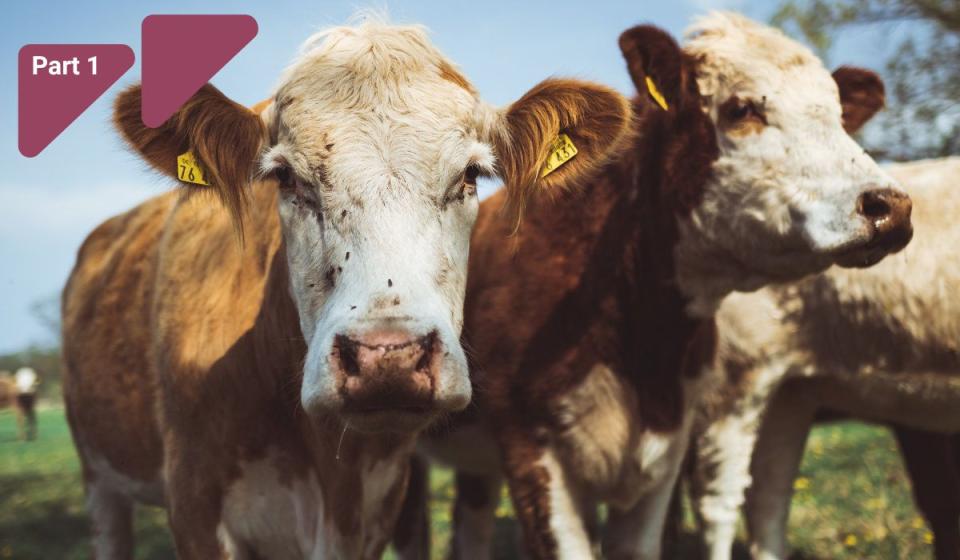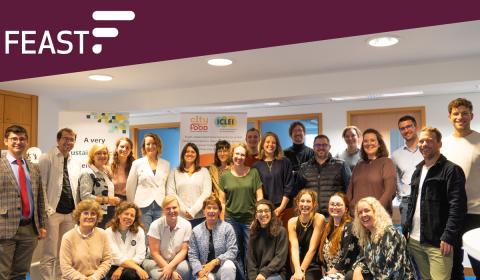
Image source: Max Saeling on Unsplash
Welcome to the new series of three blog posts on the relationship between our food and climate. This blog post explores the clash between the increasing demand for livestock products and the environmental challenges posed by methane emissions from ruminants. The focus is on methane-reducing feed additives for ruminants, their potential, challenges, and their critical role in environmental sustainability.
Introduction
The increasing demand for livestock products, especially beef and milk, conflicts with the environmental challenges posed by methane emissions from ruminants. Methane, a major concern due to its potency, constitutes 39% of the sector's total emissions. Livestock, particularly ruminants, contribute significantly to greenhouse gas emissions (GHG). Given the heightened focus on climate change, there is growing pressure on the livestock industry to minimize its environmental impact.. Enteric methane, a Short-Lived Climate Pollutant (SLCP), has a 84 times higher warming effect than carbon dioxide in the first two decades after release, making its short-term impact substantial. SLCPs are potent greenhouse gases with a shorter atmospheric lifetime than CO2 but a stronger warming effect – the sprinters in the race of climate impact – they run fast (have a strong immediate effect) but don't last long1.
The problem of methane emissions
Dietary changes, particularly through feed additives, emerge as a strategy to address methane emissions and balance environmental concerns with nutritional demands.
Ruminants release up to 12% of consumed energy as methane, a process crucial for preventing hydrogen accumulation in the rumen. Targeting methanogens directly or modifying the rumen environment offers potential solutions for reducing methane emissions. Consider 3-nitroxypropanol (3NOP), a feed additive designed to reduce methane emissions. It works by inhibiting a specific enzyme involved in methane production in the rumen, akin to putting a speed bump in the road of methane synthesis. 3NOP helps to reduce the GHG from livestock without significantly altering their overall health or productivity. In the United States, dairy farms have explored the use of 3NOP to reduce methane emissions in cows. Studies have shown a significant reduction in methane production per liter of milk, with no adverse effects on cow health or productivity. This demonstrates the effectiveness of 3NOP as a sustainable and economically viable solution in dairy farming2. Rumen modifiers alter the rumen environment, restraining methanogen growth and suppressing methane production. These include essential oils, tannins, biochar, and lipids. While promising, the accessibility and effectiveness of these feed additives vary3.
Solutions through feed additives
Promising feed additives show potential to significantly decrease enteric methane emissions, enhancing the sustainability of animal-sourced foods. Rumen inhibitors demonstrate up to a 98% reduction in methane production, though accessibility and welfare risks vary. Global availability of rumen modifiers exists, but effectiveness varies. Challenges include the consistency factor in plant-based feed additives and the lack of strong evidence for direct-fed microbials or probiotics as rumen modifiers. It is vital to critically assess their long-term effects on livestock health, consider how they might influence consumer perceptions of animal products, and understand their sustainability in the broader context of environmental management. Analyzing these factors, along with the possible trade-offs and unintended consequences, is crucial to form a comprehensive view of their role in livestock production. Ongoing research is expected to provide more insights into their effectiveness3.
The current data reveals a deficient feed additive pipeline with limitations arising from narrow target markets, inadequate understanding of emerging additives, unrealistic expectations of co-benefits, and unclear potential off-farm financial rewards. The big question is whether the success seen in total mixed rations (TMRs) can be replicated in mixed feeding systems, where difficulties emerge concerning the needed higher inclusion rate or possible short-term effectiveness4.
Additive manufacturers focus on developed countries, particularly in the feedlot and dairy industry, with little attention to the grazing industry. This disparity raises concerns about delayed access to emerging methane-suppressing additives in the developing world. Additionally, there is low interest and understanding within the feed industry regarding these additives, hindering rapid global mitigation. It's crucial to consider how methane-reducing strategies in livestock might translate to developing countries, where resources and infrastructure differ significantly from developed nations. Challenges such as limited access to advanced feed additives, cost constraints, and differing livestock management practices must be acknowledged. Moreover, exploring how these strategies can be adapted to local contexts, possibly through more accessible alternatives or government-supported initiatives, could provide valuable insights into creating a more inclusive and globally relevant approach to reducing methane emissions in livestock production4.
End-users anticipate a minimal increase in feed prices for feeds containing methane additives, expecting economic returns via productivity or external economic support. However, none of the reviewed additives provided robust evidence of productivity gains, presenting a challenge in making a business case for their inclusion. Feed manufacturers consider the cost of additives a major constraint, and livestock producers' willingness to adopt them depends on economic advantages or legislated requirements5.
Challenges and considerations
Implementing methane-reducing feed additives faces challenges in scalability, supply chain, efficiency, and shelf life4. Past experiences highlight the need for a combination of voluntary and mandatory actions to increase environmental awareness. While voluntary actions can raise awareness, financial compensation is crucial for practical solutions. Mandatory participation provides broader reach, but buy-in is essential. Effective approaches involve a mix of instruments like carbon markets and low-public-money options (e.g., voluntary standards, product labeling), which mitigate adverse effects from market and policy changes, and the participation of supply chain actors for sector transformation. Changes in the supply chain, such as low-GHG meat demand, impact scheme effectiveness. Rapid policy and economic shifts create risks, but third-party organizations can reduce obstacles4.
Long-duration feeding trials are scarce, especially for feed additives defined as drugs. Also, challenges in understanding the impact on nutrient flow to the lower gut exist due to limited use of costly research tools like duodenal and ileal cannulas. Considering feed additive durability, bromoform in Asparagopsis taxiformis has low stability, but oil immersion may prolong its shelf life. Studies often overlook manure methane and nitrous oxide emissions' impact, and feed additives influencing nutrient digestion can alter manure composition, affecting emissions4.
Conclusion
The journey from research to market for methane-reducing feed additives is complex, involving regulatory hurdles, varying levels of evidence for effectiveness, and concerns like bioaccumulation. For example, Bovaer and 3-NOP show promise but face challenges like consumer acceptability and limited evidence in some cases. Bridging the gap between scientific research and practical application requires incentives like carbon credits and effective communication among all stakeholders. Emphasizing the need for continued research and collaborative efforts, it's vital to drive forward the adoption of these sustainable practices in the livestock industry. In summary, while methane-reducing feed additives offer a promising avenue for reducing greenhouse gas emissions, their adoption is fraught with challenges including regulatory barriers, effectiveness, market acceptance, and the need for further evidence in some cases. Collaborative efforts between researchers, industry, and policymakers are essential to foster innovation and facilitate the practical application of these additives. It is imperative that we persist in research and incentivize adoption to harness the full potential of these solutions in the global fight against climate change.
References
1 Food and Agriculture Organization of the United Nations (FAO) (2016). Reducing enteric methane for improving food security and livelihoods. https://www.fao.org/in-action/enteric-methane/background/en
2 Hristov, A. N., Melgar, A., Wasson, D., & Arndt, C. (2022). Symposium review: Effective nutritional strategies to mitigate enteric methane in dairy cattle. Journal of dairy science.
3 Honan, M., Feng, X., Tricarico, J.M., & Kebreab, E. (2022). Feed additives as a strategic approach to reduce enteric methane production in cattle: modes of action, effectiveness and safety. Animal Production Science 62, 1303-1317. https://doi.org/10.1071/AN20295
4 Miller, G. A., Eory, V., Duthie, C.-A., & Newbold, JR. (2023). Existing and near-to-market methane reducing feed additives and technologies: Evidence of Efficacy, Regulatory Pathways to Market and Mechanisms to Incentivise Adoption
5 Hegarty, R.S., Cortez Passetti, R.A., Dittmer, K.M., Wang, Y., Shelton, S., Emmet-Booth, J., Wollenberg, E., McAlliste,r T., Leahy, S., Beauchemin, K., & Gurwick, N. (2021). An evaluation of emerging feed additives to reduce methane emissions from livestock. Edition 1. A report coordinated by Climate Change, Agriculture and Food Security (CCAFS) and the New Zealand Agricultural Greenhouse Gas Research Centre (NZAGRC) initiative of the Global Research Alliance (GRA). https://hdl.handle.net/10568/116489


